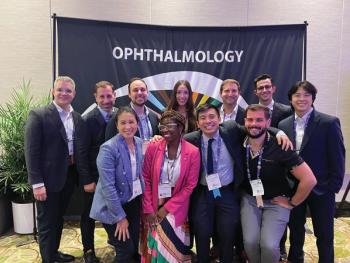
Anti-VEGF therapy may prevent/delay radiation maculopathy in choroidal melanoma
Immediate administration after radiation therapy is key.
Radiation therapy is the optimal treatment for intraocular melanoma, but the treatment itself can be associated with development of sight-threatening radiation maculopathy (RM), which has been reported to cause irreversible vision loss.1,2
Administration of anti-vascular endothelial growth factor (VEGF) may help prevent or delay the retinal damage caused by radiation when administered soon after radiation therapy.
The early clinical signs of RM are cotton-wool spots, intraretinal hemorrhages, and macular edema, and the risk of their development is related to the total dose and rate of the radiation, presence of concomitant diseases, and use of radiation sensitizers, according to Brittany Powell, MD, and Paul Finger, MD.
Two scenarios carry the highest risk of development of RM, i.e., tumors that are located subfoveally or juxtafoveally and use of a radiation dose of 50 Gray or more administered to the fovea.1-3
Finger and colleagues recently reported that in patients with intraocular melanoma, anti-VEGF treatment administered “at the onset of visually and clinically significant RM resulted in preservation of vision and less radiation-related retinal damage.”4
“We suspect that a dose-dependent, subclinical ischemic radiation vasculopathy begins at or immediately after the time of plaque placement, but only later becomes clinically apparent when it causes vision loss and progressive retinal ischemia,” Powell and Finger commented.
Taking treatment a step sooner
Considering the beneficial effect of anti-VEGF therapy in patients after the onset of RM, they hypothesized that earlier intervention with anti-VEGF therapy, i.e., before the onset of RM, may benefit those patients who were at the highest risk of vision loss.
Powell and Finger conducted a retrospective, non-randomized, interventional, comparative case-matched pilot study of the data obtained from 14 patients with choroidal melanoma who had been treated with palladium-103 plaque radiotherapy from 2014 to 2017.
The patients had been treated every 4 to 6 weeks within 6 months of plaque placement RM maculopathy became evident. These patients were matched with 14 historical cases with the same diagnosis and who had undergone radiation therapy before anti-VEGF therapy was introduced. All patients had received a high foveal dose of radiation, placing them at higher risk of developing RM.
The main outcome measures were the visual acuity (VA), clinical features of RM, and central foveal thickness measurement.
The investigators reported their results in Ophthalmology Retina.5
They found that, while the mean VAs between the two groups were similar at diagnosis, the difference was significant (p ≤ 0.05) at the final visit, i.e., 20/32 and 20/160 in the anti-VEGF group and case-matched group, respectively. The VA improvement resulted mainly from resolution of retinal detachments and subretinal fluid associated with the subfoveal tumors.
Importantly, the anti-VEGF group fared better than the case-matched group, with 7 patients having developed RM compared with the 12 in the case-matched group. In the anti-VEGF group, 6 patients had 1 cotton-wool spot and 1 had one intraretinal cyst that resolved with additional anti-VEGF injections. The 7 patients in the anti-VEGF group in whom RM did not develop remained unaffected at 33 months of follow-up, Powell and Finger noted.
At the final examination, most of those in the case-match group developed stage 3 and 4 RM (on the Finger scale from 0-4 0 indicates no effect of RM and 4 the highest stage of RM).
The central foveal thickness in the anti-VEGF group decreased by a mean of 185 microns.
The investigators concluded, “This pilot study suggests that early administration of monthly intravitreal anti-VEGF medication (bevacizumab) was well tolerated and prevented or delayed vision-threatening RM in high-risk choroidal melanoma patients after plaque therapy.”
Paul Finger, MD
E: pfinger@eyecancer.com
Brittany Powell, MD, and Paul Finger, MD, are from The New York Eye Cancer Center and the Department of Ophthalmology, The New York Eye and Ear Infirmary of Mount Sinai, New York.
Finger holds patent number 7,553,486 (“Anti-VEGF Treatment for Radiation Induced Vasculopathy”). The study was supported by the Eye Cancer Foundation, Inc., New York.
References
Finger PT, Chin KJ, Yu G-P. Risk factors for radiation maculopathy after ophthalmic plaque radiation for choroidal melanoma. Am J Ophthalmol 2010;149:608-615.
Finger PT. Radiation therapy for orbital tumors: concepts, current use, and ophthalmic radiation side effects. Surv Ophthalmol 2009;54:545-568.
Finger PT. Tumour location affects the incidence of cataract and retinopathy after ophthalmic plaque radiation therapy. Br J Ophthalmol 2000;84:1068-1070.
Finger PT, Chin KJ, Semenova EA. Intravitreal anti-VEGF therapy for macular radiation retinopathy: a 10-year study. Eur J Ophthalmol 2016;26:60-66.
Powell BE, Finger PT. Anti-VEGF therapy immediately after plaque radiation therapy prevents or delays radiation maculopathy. Ophthalmol Retina 2020;4:547-550.
Newsletter
Keep your retina practice on the forefront—subscribe for expert analysis and emerging trends in retinal disease management.




